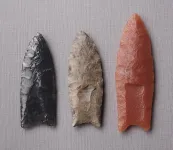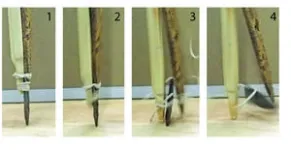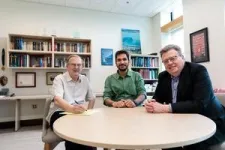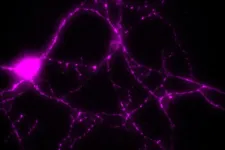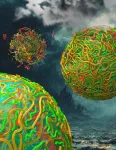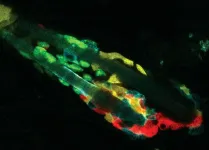(Press-News.org) How did early humans use sharpened rocks to bring down megafauna 13,000 years ago? Did they throw spears tipped with carefully crafted, razor-sharp rocks called Clovis points? Did they surround and jab mammoths and mastadons? Or did they scavenge wounded animals, using Clovis points as a versatile tool to harvest meat and bones for food and supplies?
UC Berkeley archaeologists say the answer might be none of the above.
Instead, researchers say humans may have braced the butt of their pointed spears against the ground and angled the weapon upward in a way that would impale a charging animal. The force would have driven the spear deeper into the predator's body, unleashing a more damaging blow than even the strongest prehistoric hunters would have been capable of on their own.
Drawing upon multiple sources of writings and artwork, a team of Berkeley archaeologists reviewed historical evidence from around the world about people hunting with planted spears.
They also ran the first experimental study of stone weapons that focused on pike hunting techniques, revealing how spears react to the simulated force of an approaching animal. Once the sharpened rock pierced the flesh and activated its engineered mounting system, they say, the spear tip functioned like a modern day hollow-point bullet and could inflict serious wounds to mastodons, bison and saber-toothed cats.
"This ancient Native American design was an amazing innovation in hunting strategies," said Scott Byram, a research associate with Berkeley's Archeological Research Facility and first-author of a paper on the topic published today in the journal PLOS ONE. "This distinctive Indigenous technology is providing a window into hunting and survival techniques used for millennia throughout much of the world."
The historical review and experiment may help solve a puzzle that has fueled decades of debate in archaeology circles: How did communities in North America actually use Clovis points, which are among the most frequently unearthed items from the Ice Age?
Named for the town of Clovis, New Mexico, where the shaped stones were first recovered nearly a century ago, Clovis points were shaped from rocks, such as chert, flint or jasper. They range from the size of a person's thumb to that of a midsize iPhone and have a distinct, razor-sharp edge and fluted indentations on both sides of their base. Thousands of them have been recovered across the U.S. — some have even been unearthed within preserved mammoth skeletons.
They've also been a pop culture plot point. Characters in the video game "Far Cry Primal" use spears tipped with stone points to ambush mastodons. The movie 10,000 B.C. uses a similar spear to hunt mammoths. Scholars and hobbyists reconstruct Clovis points — and some even document on YouTube the process of building them and using them to hunt bison.
Those depictions make for a good story. But they likely fail to consider the realities of life in the Ice Age, said Byram and his co-author, Jun Sunseri, a Berkeley associate professor of anthropology.
Clovis points are often the only recovered part of a spear. The intricately designed bone shafts at the end of the weapon are sometimes found, but the wood at the base of the spear and the pine pitch and lacing that help make them function as a complete system have been lost to time.
Plus, research silos limit that kind of systems thinking about prehistoric weaponry, Jun said. And if stone specialists aren’t experts in bone, they might not see the full picture.
"You have to look beyond the simple artifact," he said. "One of the things that's key here is that we're looking at this as an engineered system that requires multiple kinds of sub-specialties within our field and other fields."
Building tools as strong, effective systems was likely a priority for communities 13,000 years ago. The tools needed to be resilient. The people had a limited number of suitable rocks to work with while traversing the land. They might go hundreds of miles without access to the right kind of long, straight poles from which to fashion a spear. So it stands to reason they wouldn't want to risk throwing or destroying their tools without knowing if they'd even land the animal, said Byram, who mined archival records, spanning anthropology to art to Greek history, to trace the arc of planted pikes as weapons.
"People who are doing metal military artifact analysis know all about it because it was used for stopping horses in warfare," Byram said. "But prior to that, and in other contexts with boar hunting or bear hunting, it wasn't very well known. It's a theme that comes back in literature quite a bit. But for whatever reason, it hasn't been talked about too much in anthropology."
To evaluate their pike hypothesis, the Berkeley team built a test platform measuring the force a spear system could withstand before the point snapped and/or the shaft expanded. Their low-tech, static version of an animal attack using a braced, replica Clovis point spear allowed them to test how different spears reached their breaking points and how the expansion system responded.
It was based on prior experiments where researchers fired stone-tipped spears into clay and ballistics gel — something that might feel like a pinprick to a 9-ton mammoth.
"The kind of energy that you can generate with the human arm is nothing like the kind of energy generated by a charging animal. It's an order of magnitude different," Jun said. "These spears were engineered to do what they're doing to protect the user."
The experiment put to the test something Byram had mulled for decades. When he was in graduate school and analyzing prehistoric stone tools, he crafted replica Clovis points and fashioned spears using traditional techniques. He remembered thinking how time-intensive a process it was to invest in a stone Clovis point — and how important it would be for the point to function effectively.
"It just started to make sense to me that it actually had a different purpose than some of the other tools," Byram said. "Unlike some of the notched arrowheads, it was a more substantial weapon. And it was probably also used defensively."
Conversations around a campfire early in the pandemic between Jun, a zooarchaeologist who learned from local communities during his time in Africa, and Kent Lightfoot, a Berkeley anthropology professor emeritus, prompted them to dig into the mystery. Through talks with his VhaVenda mentors, Jun learned how the engineering that went into the butt of some spears was just as critical as the work that went into the points.
"The sophisticated Clovis technology that developed independently in North America is testimony to the ingenuity and skills that early Indigenous people employed in their cohabitation of the ancient landscape with now-extinct megafauna," said Lightfoot, a co-author of the study.
In the coming months, the team plans to further test its theory by building something akin to a replica mammoth. Using a type of slide or pendulum, they hope to simulate what an attack might have looked like as a planted Clovis-tipped pike made impact with a massive, fast-moving mammal.
"Sometimes in archaeology, the pieces just start fitting together like they seem to now with Clovis technology, and this puts pike hunting front and center with extinct megafauna," Byram said. "It opens up a whole new way of looking at how people lived among these incredible animals during much of human history."
END
To kill mammoths in the Ice Age, people used planted pikes, not throwing spears, researchers say
UC Berkeley archeologists say the findings might help resolve the debate about Clovis points and reshape how we think about what life was like roughly 13,000 years ago
2024-08-21
ELSE PRESS RELEASES FROM THIS DATE:
Using AI to link heat waves to global warming
2024-08-21
Researchers at Stanford and Colorado State University have developed a rapid, low-cost approach for studying how individual extreme weather events have been affected by global warming. Their method, detailed in a Aug. 21 study in Science Advances, uses machine learning to determine how much global warming has contributed to heat waves in the U.S. and elsewhere in recent years. The approach proved highly accurate and could change how scientists study and predict the impact of climate change on a range of extreme weather events. The ...
The role of an energy-producing enzyme in treating Parkinson’s disease
2024-08-21
An enzyme called PGK1 has an unexpectedly critical role in the production of chemical energy in brain cells, according to a preclinical study led by researchers at Weill Cornell Medicine. The investigators found that boosting its activity may help the brain resist the energy deficits that can lead to Parkinson’s disease.
The study, published Aug. 21 in Science Advances, presented evidence that PGK1 is a “rate-limiting” enzyme in energy production in the output-signaling branches, or axons, of the dopamine neurons that are affected in Parkinson’s disease. This means that even a modest boost to PGK1 activity can have ...
Life from a drop of rain: New research suggests rainwater helped form the first protocell walls
2024-08-21
One of the major unanswered questions about the origin of life is how droplets of RNA floating around the primordial soup turned into the membrane-protected packets of life we call cells.
A new paper by engineers from the University of Chicago’s Pritzker School of Molecular Engineering (UChicago PME), the University of Houston’s Chemical Engineering Department, and biologists from the UChicago Chemistry Department, have proposed a solution.
In the paper, published today in Science Advances, UChicago PME postdoctoral researcher Aman Agrawal and his co-authors ...
Surprising mechanism for removing dead cells identified
2024-08-21
Billions of our cells die every day to make way for the growth of new ones. Most of these goners are cleaned up by phagocytes—mobile immune cells that migrate where needed to engulf problematic substances. But some dying or dead cells are consumed by their own neighbors, natural tissue cells with other primary jobs. How these cells sense the dying or dead around them has been largely unknown.
Now researchers from The Rockefeller University have shown how the sensor system operates in hair follicles, which have a well-known cycle of birth, decay, and regeneration put into motion by hair follicle stem cells (HFSCs). In a new study published in Nature, ...
UC Irvine discovery of ‘item memory’ brain cells offers new Alzheimer’s treatment target
2024-08-21
Irvine, Calif., Aug. 21, 2024 — Researchers from the University of California, Irvine have discovered the neurons responsible for “item memory,” deepening our understanding of how the brain stores and retrieves the details of “what” happened and offering a new target for treating Alzheimer’s disease.
Memories include three types of details: spatial, temporal and item, the “where, when and what” of an event. Their creation is a complex process that involves storing information based on the meanings and outcomes of different experiences and forms the foundation of our ability to recall and recount them.
The study, published ...
Study shows successful use of ChatGPT in ag education
2024-08-21
By John Lovett
University of Arkansas System Division of Agriculture
FAYETTEVILLE, Ark. — Artificial intelligence tools such as ChatGPT show promise as a useful means in agriculture to write simple computer programs for microcontrollers, according to a study published this month.
Microcontrollers are small computers that can perform tasks based on custom computer programs. They receive inputs from sensors and can be used in climate and irrigation controls, food processing systems, as well as robotic and drone applications, to name a few agricultural uses.
A recent study published with the Arkansas Agricultural ...
Early interventions may improve long-term academic achievement in young childhood brain tumor survivors
2024-08-21
(MEMPHIS, Tenn. – August 20, 2024) Children who survive a brain tumor often experience effects from both the cancer and its treatment long after therapy concludes. Scientists at St. Jude Children’s Research Hospital found very young children treated for brain tumors were less prepared for school (represented by lower academic readiness scores) compared to their peers. This gap persisted once survivors entered formal schooling. Children from families of higher socioeconomic status were partially protected from the effect, suggesting that providing early developmental resources may proactively help reduce the academic achievement gap. The findings were published today in ...
Cholecystectomy not always necessary for gallstones and abdominal pain
2024-08-21
Each year, 100,000 people visit their doctor with abdominal pain, with approximately 30,000 of them diagnosed with gallstones. The standard treatment for these patients is a laparoscopic cholecystectomy. Since the 1990s, the number of surgeries has increased exponentially, despite the lack of clear international criteria. As a result, gallbladder removal is one of the most common surgeries in the Netherlands, yet it is not always effective against pain: about one-third of patients continue to experience abdominal pain after cholecystectomy. The procedure has long been an example of inappropriate care, but this is now changing.
In a 2019 study conducted by Radboud university ...
Greenhouse gas HFC-23: Abatement of emissions is achievable
2024-08-21
Hydrofluorocarbons (HFCs) are potent greenhouse gases (GHGs). The most potent of these compounds is trifluoromethane, also known as HFC-23. One kilogram of HFC-23 in the atmosphere contributes as much to the greenhouse effect as 12,000 kilograms of CO₂. It takes around 200 years for the gas to break down in the atmosphere. For this reason, more than 150 countries have committed to significantly reducing their emissions of HFC-23 as part of the Kigali Amendment to the Montreal Protocol.
The main source of HFC-23 ...
Researchers identify most common long COVID symptoms in children and teens
2024-08-21
Aug. 21, 2024--Researchers from the NIH’s RECOVER Initiative have determined what long COVID looks like in youths, based on the most common symptoms reported in a study of over 5,300 school-age children and adolescents.
Using the findings, published today in the Journal of the American Medical Association, the researchers also created indices that contain prolonged symptoms—eight for school-age children and 10 for adolescents—that together most likely indicate long COVID.
The indices are not intended to be used in making a clinical diagnosis of long COVID but will guide research to improve diagnosis, treatment, and prevention of the condition in youths.
“Many ...
LAST 30 PRESS RELEASES:
University of Phoenix College of Doctoral Studies releases white paper on AI-driven skilling to reduce burnout and restore worker autonomy
AIs fail at the game of visual “telephone”
The levers for a sustainable food system
Potential changes in US homelessness by ending federal support for housing first programs
Vulnerability of large language models to prompt injection when providing medical advice
Researchers develop new system for high-energy-density, long-life, multi-electron transfer bromine-based flow batteries
Ending federal support for housing first programs could increase U.S. homelessness by 5% in one year, new JAMA study finds
New research uncovers molecular ‘safety switch’ shielding cancers from immune attack
Bacteria resisting viral infection can still sink carbon to ocean floor
Younger biological age may increase depression risk in older women during COVID-19
Bharat Innovates 2026 National Basecamp Showcases India’s Most Promising Deep-Tech Ventures
Here’s what determines whether your income level rises or falls
SCIE indexation achievement: Celebrate with Space: Science & Technology
Children’s Hospital Colorado performs region’s first pediatric heart and liver dual organ transplant
Australian team discover why quantum computers have memory problems over time
What determines the fate of a T cell?
Candida auris: genetic process revealed which could be treatment target for deadly fungal disease
Groundbreaking discovery turns household plastic recycling into anti-cancer medication
Blocking a key inflammatory pathway improves liver structure and vascular function in cirrhosis, study finds
Continuous spread: Raccoon roundworm detected in nine European countries
HKUST Engineering researchers developed a novel photodetector to enhance the performance of on-chip light monitoring
Strategic river sensors could have forewarned of Texas Camp flood disaster
Drone sampling of whale breath reveals first evidence of potentially deadly virus in Arctic
Roman soldiers defending Hadrian’s Wall infected by parasites, study finds
Pinochet’s prisoners were tormented with music but still found solace in it, a new book reveals
Fertility remains high in rural Tanzania despite access to family planning
AI-assisted device can improve autism care access
Kinetic careers
Uncovering how parasitic plants avoid attacking themselves to improve crop resistance
Nanoparticle vaccine strategy could protect against Ebola and other deadly filoviruses
[Press-News.org] To kill mammoths in the Ice Age, people used planted pikes, not throwing spears, researchers sayUC Berkeley archeologists say the findings might help resolve the debate about Clovis points and reshape how we think about what life was like roughly 13,000 years ago
